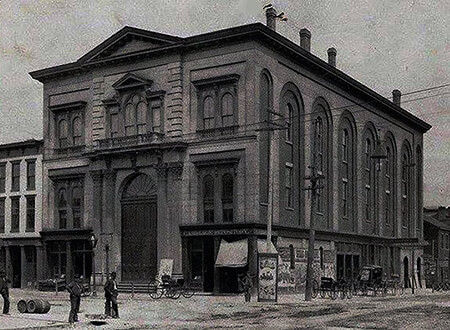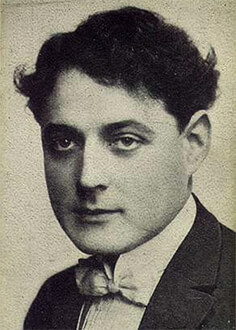LIVE THEATER IN NEW ALBANY

On November 26, 1866 the curtain was raised for the first time at the New Albany Music Hall, ushering in the golden age of the theatre in New Albany. The Music Hall, which became popularly known as the Opera House, seated 2,500 persons and was one of the finest theatres in the entire Middle West. On its ample stage appeared some of the best-known actors and actresses of the Nineteenth Century – dramatic artists who brought delight and entertainment season after season to New Albany audiences.
The Opera House represents the high point of the theatre in New Albany, but not the beginning. Just when the first theatrical performance was presented in New Albany has been lost in the mists of history, but it quite likely was an early showboat which tied up at the wharf and plastered the town with posters advertising some melodramatic play, or perhaps a display of wild animals with sword-swallowers, fire-eaters and other attractions thrown in for good measure. The showboats began their circuit up and down the river as early as the 1830s bringing entertainment and the magic of the theatre to the towns and villages lining the shore. New Albany apparently had to depend on the showboats all through the 1840s for the first building constructed as a theatre seems to have been the famous Woodward Hall built in 1852 by John K. Woodward. This building [is] still standing at the corner of Main and West First Streets, now occupied as a warehouse by a moving company. The stage itself was located on the third floor with the first and second floors occupied by stores and offices. With the opening of Woodward Hall the theatre came into its own in New Albany. Minstrels, variety acts, lecturers,dramatic companies and all sorts of entertainment enterprises now had a made-to-order theatre and the attractions were many and continuous. Many political rallies and public meetings also were held in the old Woodward Hall, including a tense meeting on the eve of the Civil War which adopted resolutions urging moderation on the part of both North and South to avoid armed conflict. Tradition says that the first performance of “Uncle Tom’s Cabin” in Indiana was presented before a packed house in Woodward Hall.
With the close of the Civil War, a number of New Albany’s leading citizens conceived the idea of building a theatre which would match the rosy future which they foresaw for New Albany – a theatre to attract the leading traveling dramatic companies. Thus it was that in November 1866, the splendid new Music Hall at Spring and Pearl was opened with pomp and ceremony. The Music Hall or Opera House as it came to be known, presented as its first attraction a popular play of the day – “Fashion, or Life in New York” – featuring Augusta Dargon, who also made the dedicatory address.
For weeks before the opening the city had been alive with rumors that the Music Hall was unsafe – “too big to stand” said the Doubting Thomases. But all this was forgotten as the Opera House began its long career. Not everybody was happy about the new theatre, though. Many ministers preached against the immorality of attending the theatre, particularly the Rev. J. H. Noble of Wesley Chapel.
But the Opera House with its private boxes, its main floor, its balcony and gallery often packed to capacity, was a success. It spelled the doom of Woodward Hall which was used only for public meetings and second-rate lecturers, and finally passed from the picture about 1880.
The Opera House reigned supreme as New Albany’s place of entertainment until well after the turn of the century. No doubt its management noted with a patronizing smile the tent shows that began to appear here and there in the city, showing crude silent motion pictures while a pianist played music appropriate to the action on the screen. But in 1908 the movies were taken out of the tents and were shown in the first motion picture theatres in New Albany – the old nickelodeons.

That was the year the Princess, downtown on Main Street, the Heath, on Vincennes, and the Grand (Pictured Above), still in business at its original location, sprang into existence. The next year or two saw the motion picture theatres multiply at an amazing rate. By 1911 there were eight – the Princess, Crystal, Grand, Liberty, Majestic, Mammoth, Star and Victoria.
This was a new era of entertainment and the stage found it could not compete with the movies except in the largest cities. In 1912 the Opera House stopped trying to compete and during succeeding years became the scene of poultry shows, amateur productions, a roller skating rink, and tried to make a comeback as a movie theatre called the Hippodrome. But it was no use. Time had run out and the Opera House became dark and deserted except for stores in the first floor.
Then on a cold, raw March night in 1939, the final and most dramatic act was played. The Opera House was afire – and as the searing flames leaped through the building, many older residents watched and recalled earlier and better days when the hush fell over the audience as the huge curtain was slowly raised. Today the Opera House is still there – part of it – transformed into downtown stores.
The new movie theatres, which had come out in such force in the early days, also found competition was a leveler. Many dropped by the wayside and a few new ones opened. In 1914 the Kerrigan went into business on Main street in a building which has been torn down to make way for the Municipal Parking Lot. It was named for Warren Kerrigan (Pictured Below), a New Albany boy who became a matinee idol in the early days of movies.

In the early 1920s the Elba, later named the Indiana, opened on Vincennes at Spring. The Elks Club building, opened in 1921, contained a theatre which operated until a few years ago. The Indiana closed about two years ago – a victim of television. But the Grand, one of the first, still continues after nearly 50 years – a first cousin to the showboats which first brought the world of the theatre to New Albany.
Story - NAFC Public Library
Images - Indiana Historical Society / NAFC Library Archives